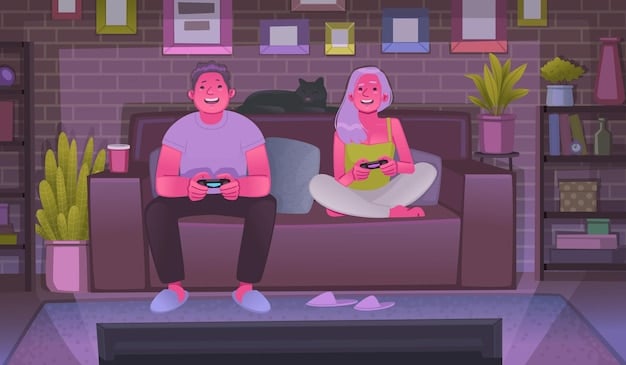The Sitcom’s Back? Exploring the Return of Classic TV Formats

The Return of the Sitcom: Are Classic TV Formats Making a Comeback? The resurgence of sitcoms can be attributed to a yearning for comforting, familiar television experiences in today’s fast-paced media landscape, with classic tropes and updated narratives finding renewed popularity.
Is the humble sitcom making a comeback? In an era dominated by streaming services and complex dramas, the simple charm of classic TV formats seems to be striking a chord with audiences – let’s explore The Return of the Sitcom: Are Classic TV Formats Making a Comeback? and if nostalgia can reclaim its spot in prime time.
Why Are Sitcoms Popular Again?
The popularity of sitcoms is cyclical, but there are distinct reasons why they’re finding renewed favor today. From their easily digestible narratives to their comforting familiarity, sitcoms offer a unique viewing experience that contrasts with the often-dark, serialized content that dominates modern television.
Nostalgia and Comfort
One key factor is nostalgia. Many viewers grew up with sitcoms, and revisiting these formats provides a sense of comfort and familiarity. This is especially true for classic sitcoms available on streaming platforms.
Simplicity in Storytelling
Sitcoms typically feature self-contained episodes with simple, relatable storylines. This makes them easy to watch and doesn’t require the same level of commitment as more complex dramas.
- Nostalgia plays a huge role in their resurgent popularity.
- Easy to watch, simpler plots.
- Sitcoms are usually short, sweet, and to the point.
- Comforting to watch.
Sitcom’s short running time in a world where time is of the essence is a great way to consume entertainment for a short amount of time without taking up too much of your day.

The return of sitcoms is also influenced by the demand for lighthearted entertainment. In a world filled with stress and uncertainty, sitcoms offer a welcome escape and a chance to laugh.
The Evolution of Sitcom Humor
Sitcoms haven’t remained static through the decades; they’ve evolved to reflect changing social attitudes and comedic sensibilities. Modern sitcoms often tackle more complex and nuanced topics than their predecessors, while still maintaining the core elements that make the format appealing.
Modern vs. Classic Humor
Classic sitcoms often relied on broad, physical humor and stereotypical characters. Modern sitcoms tend to be more character-driven and rely on clever writing and relatable situations.
Addressing Social Issues
Many modern sitcoms incorporate social commentary and address important issues like diversity, inclusivity, and mental health. This makes them more relevant to contemporary audiences.
Modern sitcoms sometimes tackle tough subjects that were never available for discussion when prior sitcoms were made.
- More diversity in modern shows.
- Modern sitcoms tend to be more character-driven and rely on clever writing and relatable situations.
- The storylines can be more varied and interesting to watch.
- More representation among actors/actresses.
The evolution of humor is also tied to changing social norms, what was appropriate five years ago might not be now. As society evolves, sitcoms do as well.
Key Elements of a Successful Sitcom
While the specific ingredients of a successful sitcom can vary, there are some common elements that contribute to their appeal. Strong writing, relatable characters, and a consistent tone are all essential for creating a sitcom that resonates with audiences.
Strong Writing and Character Development
Well-developed characters and witty dialogue are crucial. Viewers need to connect with the characters and find their interactions engaging. Writers need to know how to deliver good comedy.
Relatable Situations and Universal Themes
Sitcoms often explore relatable situations that viewers can easily connect with, such as family dynamics, relationships, and workplace challenges. The characters the actors portray should be relatable to the viewers.
A good topic to keep in mind that sitcoms tend to do is focus on family dynamics and workplace challenges especially since those are the most common instances where people have interpersonal relationships.

Consistent Tone and Predictability
Sitcoms usually maintain a consistent tone, offering viewers a predictable and reliable viewing experience. This predictability can be comforting and reassuring.
- Good writing is a cornerstone of a successful program.
- Good character choices.
- A good storyline.
- Characters who resonate with viewers.
Relatability is one of the most important things when it comes to writing sitcoms, if people cannot relate to the characters that are on screen, they will not connect.
Sitcoms vs. Other TV Genres
Sitcoms occupy a unique space within the television landscape. Unlike dramas or reality shows, sitcoms prioritize humor and character-driven storytelling. This makes them a distinct and valuable form of entertainment as opposed to things like reality tv.
Dramas
Dramas often focus on complex plots and intense emotional experiences. Sitcoms, on the other hand, prioritize levity and lightheartedness.
Reality Shows
Reality shows aim to capture unscripted moments and real-life conflicts. Sitcoms are fictional and rely on carefully crafted scripts and performances.
The main difference between a sitcom and a reality show is that a sitcom is planned out with a script of actors and actresses while a reality show tends to be completely spontaneous (though that is not always the case).
- Sitcoms are meant to be fun and lighthearted.
- Sitcoms usually involve planned scripts.
- Sitcoms focus on humor.
- Sitcoms are also usually short.
As mentioned before, Sitcoms are usually short, sweet, and to the point with episodes usually ranging between the twenty and thirty-minute mark.
The Impact of Streaming Services
Streaming services have played a significant role in the resurgence of sitcoms. These platforms offer a vast library of both classic and modern sitcoms, making them easily accessible to viewers. The influence streaming services has had on media cannot be understated.
Accessibility and Binge-Watching
Streaming services allow viewers to watch sitcoms anytime, anywhere. The ability to binge-watch entire seasons has also contributed to their popularity.
Revivals and Reboots
Streaming platforms have also fueled the trend of sitcom revivals and reboots, bringing back beloved characters and storylines for new audiences. Many sitcoms have been revived just because of the popularity of streaming services.
Streaming services are great for people who may not have had the channels that most sitcoms are shown on TV. With something like Netflix, anyone can watch any show they desire.
- More shows are available on demand.
- People are finally able to binge their old favorite shows.
- Sitcoms are now more available to a wider audience.
- Old sitcoms are constantly rebooted.
Not only are sitcoms being rebooted, they are also being remade for younger audiences, which brings a lot of nostalgia for the older audiences as well.
The Future of Sitcoms
The future of sitcoms looks bright. As audiences continue to seek out lighthearted and comforting entertainment, the sitcom format is likely to remain a popular choice. We can only expect that the format of sitcoms will just keep building and growing.
Innovation and Experimentation
While classic sitcom formats are still appealing, there’s also room for innovation and experimentation. New sitcoms are pushing the boundaries of the genre and exploring new comedic territory.
Continued Popularity on Streaming Platforms
Streaming services will continue to be a major platform for sitcoms, offering both new and classic content to a wide audience.
As time goes on we can expect to see more diversity in the sitcom space, more people behind the camera and more inclusive casting and writing. The future is bright when it comes to sitcoms.
- Sitcoms are able to be more creative.
- Streaming services will keep sitcoms going.
- Expect to see more people of color, members of the LGBTQ community, and underrepresented groups.
- Streaming will be the next big thing.
With streaming on the rise, who knows, maybe sitcoms will be the next thing that is popular!
| Key Point | Brief Description |
|---|---|
| 📺 Nostalgia | Sitcoms recall memories of past, simpler times, making viewing comforting. |
| 😂 Lightheartedness | Sitcoms offer a welcome break to life’s seriousness; entertainment for all. |
| 🔄 Evolution | Modern sitcoms are relevant thanks to inclusivity and the addressing of important topics. |
| 🌐 Streaming | Streaming brings sitcoms to a broad, on-demand audience, enhancing their reach. |
FAQ
▼
A sitcom, short for “situation comedy,” is a genre of comedy centered around fixed characters who carry over from episode to episode, usually with a plot that has a lighthearted or humorous tone.
▼
Sitcoms provide comfort through familiar characters, consistent formats, and predictable humor, offering a sense of stability and relaxation that contrasts with the complexity of real-life situations.
▼
Sitcoms have changed through diverse casting, addressing social issues, developing storylines, and embracing new forms of humor while mostly keeping to the same, but effective, episode structure and characters.
▼
Sitcoms have exploded with great entertainment because of streaming access, social media influences, and the ability of some sitcoms to address more modern and relevant issues.
▼
Sitcoms thrive with unique, well-rounded casts, relatable and captivating storylines, a strong comedic element, and the capacity to resonate across different age or cultural demographics.
Conclusion
In conclusion, the resurgence of sitcoms speaks volumes about our collective need for comfort, humor, and connection in a rapidly changing world. Whether through nostalgic revisits to beloved classics or embracing the fresh perspectives of modern shows, the enduring appeal of the sitcom format confirms its place as a vital form of entertainment. As technology advances and viewing habits evolve, sitcoms continue to adapt and innovate, ensuring their relevance for generations to come.





